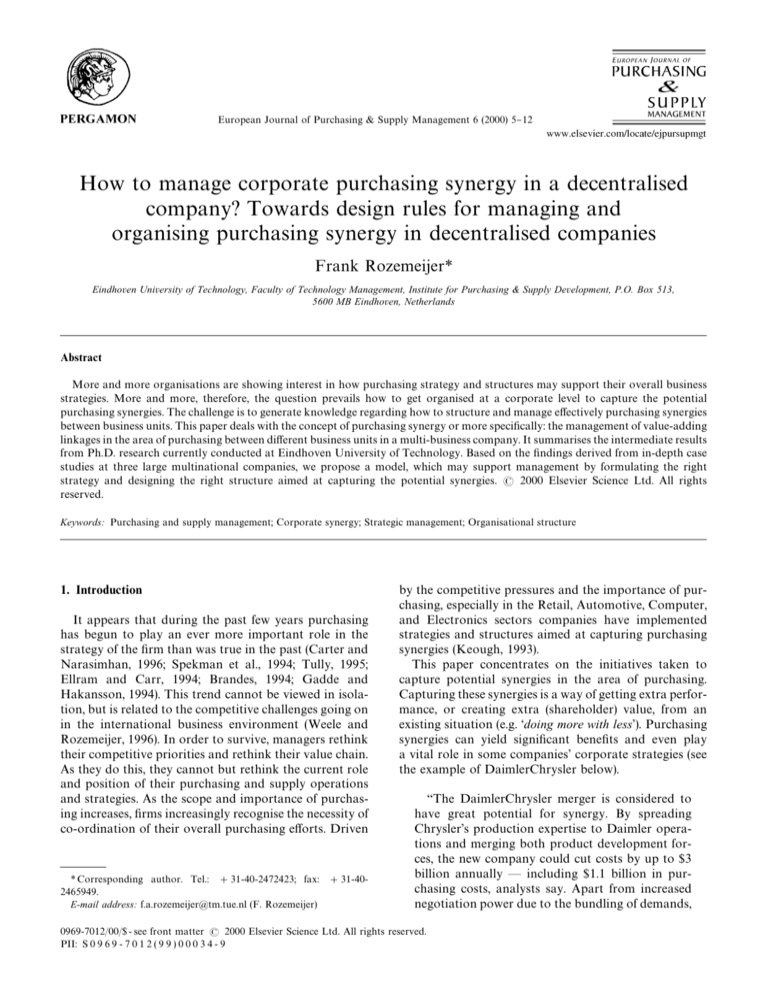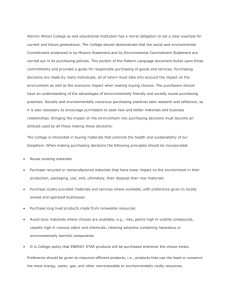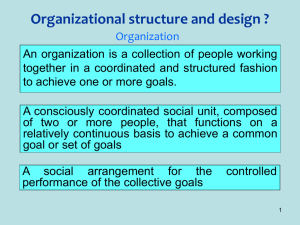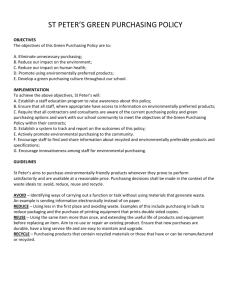
European Journal of Purchasing & Supply Management 6 (2000) 5}12
How to manage corporate purchasing synergy in a decentralised
company? Towards design rules for managing and
organising purchasing synergy in decentralised companies
Frank Rozemeijer*
Eindhoven University of Technology, Faculty of Technology Management, Institute for Purchasing & Supply Development, P.O. Box 513,
5600 MB Eindhoven, Netherlands
Abstract
More and more organisations are showing interest in how purchasing strategy and structures may support their overall business
strategies. More and more, therefore, the question prevails how to get organised at a corporate level to capture the potential
purchasing synergies. The challenge is to generate knowledge regarding how to structure and manage e!ectively purchasing synergies
between business units. This paper deals with the concept of purchasing synergy or more speci"cally: the management of value-adding
linkages in the area of purchasing between di!erent business units in a multi-business company. It summarises the intermediate results
from Ph.D. research currently conducted at Eindhoven University of Technology. Based on the "ndings derived from in-depth case
studies at three large multinational companies, we propose a model, which may support management by formulating the right
strategy and designing the right structure aimed at capturing the potential synergies. ( 2000 Elsevier Science Ltd. All rights
reserved.
Keywords: Purchasing and supply management; Corporate synergy; Strategic management; Organisational structure
1. Introduction
It appears that during the past few years purchasing
has begun to play an ever more important role in the
strategy of the "rm than was true in the past (Carter and
Narasimhan, 1996; Spekman et al., 1994; Tully, 1995;
Ellram and Carr, 1994; Brandes, 1994; Gadde and
Hakansson, 1994). This trend cannot be viewed in isolation, but is related to the competitive challenges going on
in the international business environment (Weele and
Rozemeijer, 1996). In order to survive, managers rethink
their competitive priorities and rethink their value chain.
As they do this, they cannot but rethink the current role
and position of their purchasing and supply operations
and strategies. As the scope and importance of purchasing increases, "rms increasingly recognise the necessity of
co-ordination of their overall purchasing e!orts. Driven
* Corresponding author. Tel.: #31-40-2472423; fax: #31-402465949.
E-mail address: f.a.rozemeijer@tm.tue.nl (F. Rozemeijer)
by the competitive pressures and the importance of purchasing, especially in the Retail, Automotive, Computer,
and Electronics sectors companies have implemented
strategies and structures aimed at capturing purchasing
synergies (Keough, 1993).
This paper concentrates on the initiatives taken to
capture potential synergies in the area of purchasing.
Capturing these synergies is a way of getting extra performance, or creating extra (shareholder) value, from an
existing situation (e.g. &doing more with less'). Purchasing
synergies can yield signi"cant bene"ts and even play
a vital role in some companies' corporate strategies (see
the example of DaimlerChrysler below).
`The DaimlerChrysler merger is considered to
have great potential for synergy. By spreading
Chrysler's production expertise to Daimler operations and merging both product development forces, the new company could cut costs by up to $3
billion annually * including $1.1 billion in purchasing costs, analysts say. Apart from increased
negotiation power due to the bundling of demands,
0969-7012/00/$ - see front matter ( 2000 Elsevier Science Ltd. All rights reserved.
PII: S 0 9 6 9 - 7 0 1 2 ( 9 9 ) 0 0 0 3 4 - 9
6
F. Rozemeijer / European Journal of Purchasing & Supply Management 6 (2000) 5}12
they can share their best-practices in the area of
purchasing. Chrysler, for its part, has the industry's
best supplier relations, while Daimler still relies on
strong-arm techniques to get lower prices from its
suppliers (Anonymous, 1998).
Although it is generally recognised as one of the key
issues today, the debate about the organisation and management of corporate purchasing synergy is somewhat
neglected in current purchasing literature. Strategies and
structures aimed at capturing synergies, as currently implemented in several large companies (Weele and
Rozemeijer, 1996), have not yet been the topic of scienti"c
research.
2. Objective
Both in the literature and in practice there is still
limited knowledge on how to realise sustainable purchasing synergy on a corporate level, while maintaining the
advantages of decentralisation. That is the major reason
why we have initiated a Ph.D. research project aimed at
generating knowledge on this subject. Based on research,
this paper takes a close-in look at how purchasing
synergy can be de"ned and what di!erent approaches are
used in theory and practice to capture the synergy. This
paper tries to answer whether there is a link between
di!erent forms of synergy and di!erent kinds of mechanisms, and whether purchasing synergy initiatives need
to be crafted to meet the speci"cs of each situation.
Eventually, this paper aims at delivering practical guidelines that help management to choose workable interventions to address particular opportunities for purchasing
synergy.
3. Methodology
We started this research project with a literature
study. Further, we conducted in-depth case research.
Empirical validation of the insights presented in this
paper is limited to three companies from the Financial
Services, Electronics and Pharmaceutical sectors. This
validation was carried out by reviewing existing and
developing purchasing synergy initiatives. We have carried out this "eld research over a period of about one
year. The three participating companies were examined
through:
f the use of semi-structured interviews
f interviews with large number (10}15) of people from
di!erent functions and di!erent hierarchical levels
(general management and the management of purchasing, production, product development, and
"nance and accounting)
f direct observation of company behaviour
f examination of purchasing reports, notes from meetings, project documentation and other (general) company documentation
Additionally, a number of roundtables were organised in
which the ideas presented here were tested and developed
further in close collaboration with the representatives
from the participating companies.
4. Theoretical 5ndings
Our "rst research question for theoretical study was
aimed at "nding a proper de"nition for purchasing
synergy. According to Goold and Campbell (1998)
synergy is derived from the Greek word &synergos',
which literally means &working together'. In business
usage, synergy refers to `the ability of two or more
units to generate greater value working together than
each of them could by working aparta. Often this
is illustrated with the equation: 1#1"3. Scanning
our library system on the keyword `synergya, we
came across a large number of articles and books describing initiatives to capture (purchasing) synergies.
Based on the work of Goold and Campbell (1998) we
state that most business synergies take one of six forms
(see below).
Pooled negotiation power (buying together): By combining their purchases, di!erent units can gain greater leverage over suppliers, reducing the cost or even improving
the quality of the goods they buy. Companies can also
gain similar bene"ts by negotiating jointly with other
stakeholders, such as other companies, competitors, customers, governments, or universities. A lot of references
to pooled negotiation power with other stakeholders can
be found. The terms used for these kinds of co-operation
di!er with the business sector: Co-operative purchasing
(public sector), Consortium purchasing (industrial companies), Group purchasing (health care) and Buying of"ce (Retail) (Essig, 1998).
Sharing intangible resources (knowledge and information): Firstly, business units (BU) can improve their results by pooling their insights into a particular process
(e.g. formulating purchasing strategies, applying stateof-the-art purchasing tools and techniques, developing
purchasing skills and competencies, gaining access to
world-class suppliers), function, or geographic area.
Value can be created simply by exposing one set of
people to another. The emphasis that many companies
place on leveraging core competencies and sharing best
practices re#ects the importance attributed to sharing
knowledge. Secondly, business units can improve their
position by exchanging and sharing information about
product speci"cations, company wide contracts, product
prices, suppliers, purchasing procedures, and supply
market developments.









